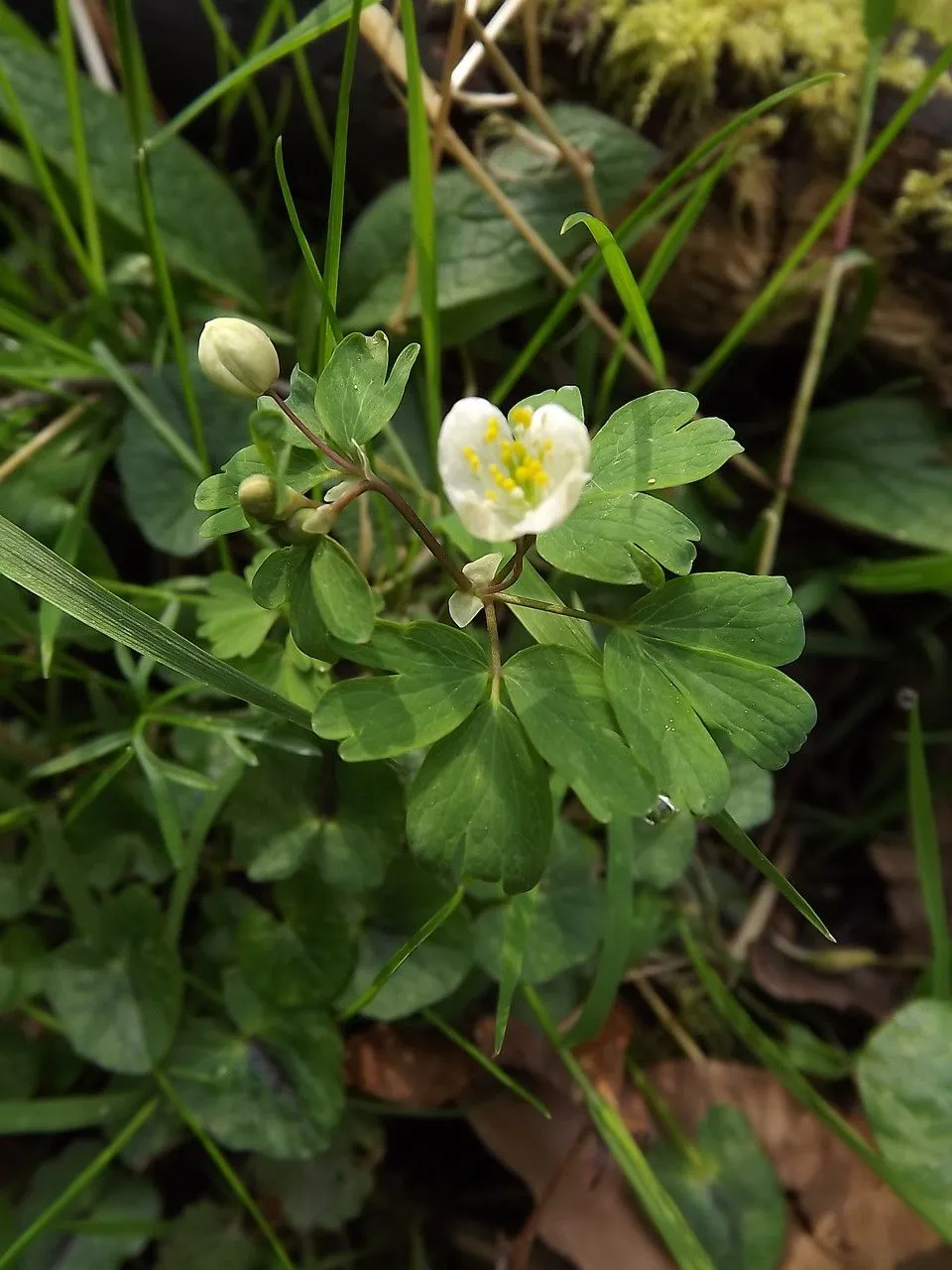
Author: L.
Bibliography: Sp. Pl.: 557 (1753)
Year: 1753
Status: accepted
Rank: species
Genus: Isopyrum
Vegetable: False
Observations: Europe
Isopyrum, also known by its scientific name Isopyrum thalictroides, is a delicate and captivating member of the Ranunculaceae family. Native to the serene landscapes of Europe, this perennial herbaceous plant adds a gentle elegance to the regions it inhabits. First described by the eminent botanist Carl Linnaeus in his seminal work Species Plantarum in 1753, Isopyrum thalictroides has since intrigued botanists and plant enthusiasts alike.
The foliage of Isopyrum is particularly notable for its fine, fern-like appearance, which might remind one of the maidenhair ferns with its light, airy structure. The leaves are typically divided into numerous small segments, contributing to the plant’s overall dainty and somewhat ethereal look. This intricate foliage forms a lush, green ground cover, making it a popular choice for ornamental gardening in shaded or woodland areas.
In spring, Isopyrum produces petite, star-shaped flowers that are typically white, although subtle variations in hue can occur. These flowers, perched on slender stems, create a striking contrast against the deep green leaves, adding a burst of brightness to the undergrowth during the blooming season. The blossoms not only enhance the beauty of gardens and natural woodlands, but they also play a role in the ecosystem by attracting pollinators such as bees and butterflies.
Growing Isopyrum in a garden setting is relatively straightforward, provided that its basic needs are met. It thrives best in moist, well-drained soil and prefers the dappled sunlight found in woodland areas, mimicking its native habitats. This plant is particularly suited for use in shaded garden borders or as part of a naturalistic planting scheme where its subtle beauty can be appreciated close-up.
Overall, Isopyrum thalictroides is a charming and understated plant that offers both aesthetic appeal and ecological benefits. Its historical botanical significance, coupled with its pleasing visual characteristics, ensures that it will continue to be valued by gardeners and plant lovers for many years to come.
Dan: frøstjerneanemone
Deu: wiesenrauten-muschelblümchen
Eng: isopyrum
Swe: vitsippsruta
En: Isopyrum, Rue Anemone
Ar: إصفورن تلكترمي
Be: Раўнаплоднік пылюшнікавы
Bg: Кокошка
Cs: Zapalice žluťuchovitá
Da: Frøstjerneanemone
Fi: Vuokkoängelmä
Fr: Isopyre faux Pigamon
De: Wiesenrauten-Muschelblümchen, Doldocke, Muschelblümchen
Hu: Galambvirág
It: Isopiro comune
Lt: Trilapė bligna
Pl: Zdrojówka rutewkowata
Ru: Равноплодник василистниковый
Es: Hierba del fuego
Sv: Vitsippsruta
Uk: Рутвичка звичайна
Taken Apr 3, 2019 by My Lord (cc-by-sa)
Taken Apr 7, 2020 by Adam Pustějovský (cc-by-sa)
Taken Mar 11, 2022 by colas Thierry (cc-by-sa)
Taken Mar 19, 2022 by Jitka Kadlecová (cc-by-sa)
Taken Apr 10, 2021 by Myshka Oksana (cc-by-sa)
Taken Mar 30, 2019 by Jean-Francois Dumas (cc-by-sa)
Taken Feb 5, 2021 by Ladišić Lucija (cc-by-sa)
Taken Mar 4, 2021 by georges fannechere (cc-by-sa)
Taken Apr 13, 2009 by Tela Botanica − Mathieu MENAND (cc-by-sa)
Taken Mar 18, 2017 by grrrr (cc-by-sa)
Taken Feb 21, 2013 by Tela Botanica − Florent Beck (cc-by-sa)
Taken Feb 8, 2014 by Tela Botanica − Alain LÉTRANGE (cc-by-sa)
Taken Mar 5, 2020 by Jiří Vilím (cc-by-sa)
Taken Mar 26, 2022 by huy HO (cc-by-sa)
Taken Mar 21, 2021 by Francois Mansour (cc-by-sa)
Taken Apr 15, 2009 by Photoflora – Benoit BOCK (©)
Taken Apr 15, 2009 by Photoflora – Benoit BOCK (©)
Taken Apr 15, 2009 by Photoflora – Benoit BOCK (©)
Taken Apr 15, 2009 by Photoflora – Benoit BOCK (©)
Taken Apr 8, 2018 by Tela Botanica − Sylvain PIRY (cc-by-sa)
Taken Mar 21, 2013 by Tela Botanica − Florent Beck (cc-by-sa)
Taken Apr 18, 2015 by Tela Botanica − Jean-Claude CALAIS (cc-by-sa)
Taken Apr 18, 2015 by Tela Botanica − Jean-Claude CALAIS (cc-by-sa)
Taken Apr 25, 2013 by Tela Botanica − Jean-Claude CALAIS (cc-by-sa)
Taken Apr 2, 2015 by Tela Botanica − liliane pessotto (cc-by-sa)
Ph maximum: 7.5
Ph minimum: 7.0
Light: 4
Atmospheric humidity: 8
Bloom months: [‘mar’, ‘apr’, ‘may’]
Soil nutriments: 6
Family: Myrtaceae Author: (F.Muell.) K.D.Hill & L.A.S.Johnson Bibliography: Telopea 6: 402 (1995) Year: 1995 Status:…
Family: Rubiaceae Author: Pierre ex A.Froehner Bibliography: Notizbl. Bot. Gart. Berlin-Dahlem 1: 237 (1897) Year:…
Family: Sapindaceae Author: Koidz. Bibliography: J. Coll. Sci. Imp. Univ. Tokyo 32(1): 38 (1911) Year:…
Family: Asteraceae Author: A.Gray Bibliography: Pacif. Railr. Rep.: 107 (1857) Year: 1857 Status: accepted Rank:…
Family: Fabaceae Author: Medik. Bibliography: Vorles. Churpfälz. Phys.-Ökon. Ges. 2: 398 (1787) Year: 1787 Status:…
Family: Aspleniaceae Author: (Cav.) Alston Bibliography: Bull. Misc. Inform. Kew 1932: 309 (1932) Year: 1932…